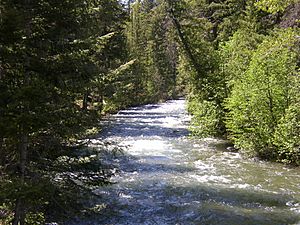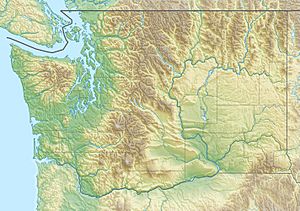Bumping River facts for kids
Quick facts for kids Bumping River |
|
|---|---|

Bumping River
|
|
|
Location of the mouth of the Bumping River in Washington
|
|
| Country | United States |
| State | Washington |
| Region | Yakima County |
| Physical characteristics | |
| Main source | Fish Lake (Yakima County, Washington) 4,155 ft (1,266 m) 46°45′34″N 121°26′19″W / 46.75944°N 121.43861°W |
| River mouth | Naches River 2,555 ft (779 m) 46°59′18″N 121°5′38″W / 46.98833°N 121.09389°W |
| Length | 25 mi (40 km) |
| Basin features | |
| Tributaries |
|
The Bumping River is a river in Washington State, USA. It flows into the Naches River. A river that flows into another river is called a tributary.
This river starts high up on the east side of the Cascade Range mountains. It flows through the beautiful Wenatchee National Forest and the William O. Douglas Wilderness area.
The Bumping River begins at Fish Lake, close to Crag Mountain. From there, it flows northeast into Bumping Lake. This lake is natural, but a dam called Bumping Lake Dam makes it bigger and helps control its water level.
After the dam, the river keeps flowing northeast. Another river, the American River, joins it. The American River is the Bumping River's biggest 'helper' river. A little further on, the Bumping River meets the Little Naches River. Together, they form the main Naches River.
Where the Bumping River Flows
The Bumping River is part of a much larger water system. It flows into the Naches River. The Naches River then flows into the Yakima River. Finally, the Yakima River joins the mighty Columbia River. This means the Bumping River's water eventually reaches the Pacific Ocean through the Columbia River.
How the River Got Its Name
Have you ever wondered how the Bumping River got its interesting name? Old-time stockmen (people who work with livestock) had a story about it.
They said that during a freshet, which is when a river suddenly gets a lot of water and flows very fast, heavy rocks and boulders would be carried downstream. As these big rocks tumbled along, they would hit and "bump" into each other. This created a loud rumbling sound and a shaking feeling. That's how the river got its name!
The United States Geological Survey (USGS) also lists other names that were once used for this river, like Tancum River and Tanum River.



